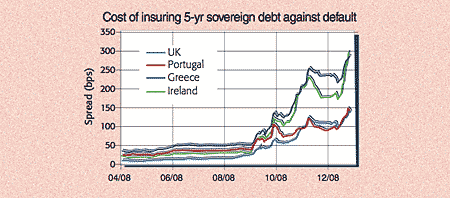Bankrupt Britain? It's not as bad as you think
Many people think the massive cost of the banking bail-outs will lead Britain to bankruptcy. James Ferguson isn't so sure. So what's the real worst-case scenario?
In last week's issue, I wrote about how the government's latest confused mish-mash of a banking bail-out was likely to do more harm than good. We also reported on fears that bailing out the system could leave Britain facing bankruptcy. It's something that investors certainly seem to be concerned about the CDS (credit default swap) spread on the five-year gilt (the cost of insuring against default) is now higher than Portugal's, a country whose debt has just been downgraded. But I'm not so sure.
Don't get me wrong I look at the blasted financial landscape that Gordon 'Culpability' Brown has fashioned for us and I could weep. But does that mean the country is actually bankrupt? Those who are most concerned point to the near-£4.2trn in liabilities that would transfer to the government's balance sheet if RBS, Barclays and Lloyds (plus HBOS) were nationalised. That would take Government debt from 40% of GDP to 350%. But this ignores the £4.4trn in assets that would accompany the liabilities (the £0.2trn difference represents the banks' capital).
So what's the real worst-case scenario? Banks will go bankrupt during this recession (or not) depending on whether the value of their assets (loans and securities) drops by more (or less) than the value of their capital buffer. It's that simple. We can argue all we like about whether we should include write-downs on assets that are never sold, or just realised losses. We can argue all we like about the definition of capital. But at the end of the day, a loss ratio of around 4.5% would wipe out the banks' capital, after which, once nationalised, the taxpayer would have to take any further losses. So how bad could those losses get?
MoneyWeek
Subscribe to MoneyWeek today and get your first six magazine issues absolutely FREE

Sign up to Money Morning
Don't miss the latest investment and personal finances news, market analysis, plus money-saving tips with our free twice-daily newsletter
Don't miss the latest investment and personal finances news, market analysis, plus money-saving tips with our free twice-daily newsletter
The first answer is: not quite as bad as you might think, especially if the authorities make the holders of bank debt (the bondholders) share the pain as well as the holders of equity. Another benefit that state-sponsored bail-outs have is that the default rate is kept to a minimum. When banks are trying to repair their balance sheets, they foreclose on otherwise viable borrowers. But the state can afford to allow all those who keep paying the interest on their loans to stay solvent. The state also doesn't need to sell off assets at firesale prices to raise cash in a hurry. This limits the scale of property-market deflation and the state may even turn a profit if the collateral assets are held long enough for the economy to recover.

So what sort of losses are we looking at? Goldman Sachs estimate £350bn of assets are 'toxic' but collateral cover means losses would be mitigated. Collateral sales would likely result in recovery rates of about two-thirds, suggesting final realised losses of £120bn. That's 8% of GDP, but less than existing bank capital. The country's hardly going bankrupt on that basis. UK government debt is 40% of GDP, excluding the bank bail-out costs to date. That's way less than Germany or France in the 60%-70% range; Italy in excess of 100%; or Japan's at 180%.
Unfortunately, Goldman is probably being too optimistic. New York University Professor Nouriel Roubini now reckons total losses on US-originated loans will come in at $3.6trn, with about $1.8trn taken by US banks and brokers, and $1.4trn abroad, mainly in Europe. With US banks and brokers having just $1.4trn in capital, it's clear Britain is by no means the only country where the banking system is essentially bust. Many European countries are no better.
We know from a Bank of England study of 33 past bank crises that once a currency has fallen as much as sterling has, the direct costs to the government of a bank bail-out average nearly 18% of GDP. That's £250bn in today's money, which dwarfs both the £37bn we've had to spend so far and also Goldman Sachs' £120bn 'worst-case' scenario. Yet even this would 'only' take government debt to around 60% of GDP still some way below the European average forecast figure of 73% by 2011.
There are many other things that will drive government debt higher (not least falling tax receipts and rising unemployment benefit) but this will be the case for almost all countries, not just ours. Yes, we have a scarily indebted household sector and yes, we have a current-account deficit, but sterling has dropped by a third since July and, given the usual lags, that could provide something of a boost to the trade balance.
The reason why Britain was driven to the International Monetary Fund (IMF) in 1976 for a bail-out was not so much because national debt was so high as because the cost of servicing it was almost 5% of GDP a year (interest rates were higher then). The current burden is about half that, so even a doubling of government debt (although by no means unlikely before this crisis is done) wouldn't be a total disaster, as long as interest rates stay low. That depends on how easy it'll be to find buyers for the big surge in planned gilt issuance.
The FT Lex column pooh-poohs the "conventional wisdom" that the domestic banking system will mop up government bond issuance as in previous banking crises. But this ignores the fact that the banks' new imperative is to swap risky assets for risk-free ones. The wide spreads available in very low-risk corporate debt simply aren't tempting to a banking sector that has just learned a near-fatal lesson in the difference between risk-free and nearly risk-free. Banks will buy gilts this banking crisis for exactly the same reasons banks buy government bonds in any banking crisis because they have no real choice in the matter.
James Ferguson is chief strategist at Pali International. He also writes theModel Investor newsletter.
Get the latest financial news, insights and expert analysis from our award-winning MoneyWeek team, to help you understand what really matters when it comes to your finances.
James Ferguson qualified with an MA (Hons) in economics from Edinburgh University in 1985. For the last 21 years he has had a high-powered career in institutional stock broking, specialising in equities, working for Nomura, Robert Fleming, SBC Warburg, Dresdner Kleinwort Wasserstein and Mitsubishi Securities.
-
 The best Christmas markets in Europe to visit this winter
The best Christmas markets in Europe to visit this winterWe round up the best Christmas markets in Europe for the perfect festive break – from Portugal to Switzerland
-
 How much would it cost you to buy a house in Great Britain's happiest places?
How much would it cost you to buy a house in Great Britain's happiest places?Average asking prices for a property in the happiest place in Britain are below the national average